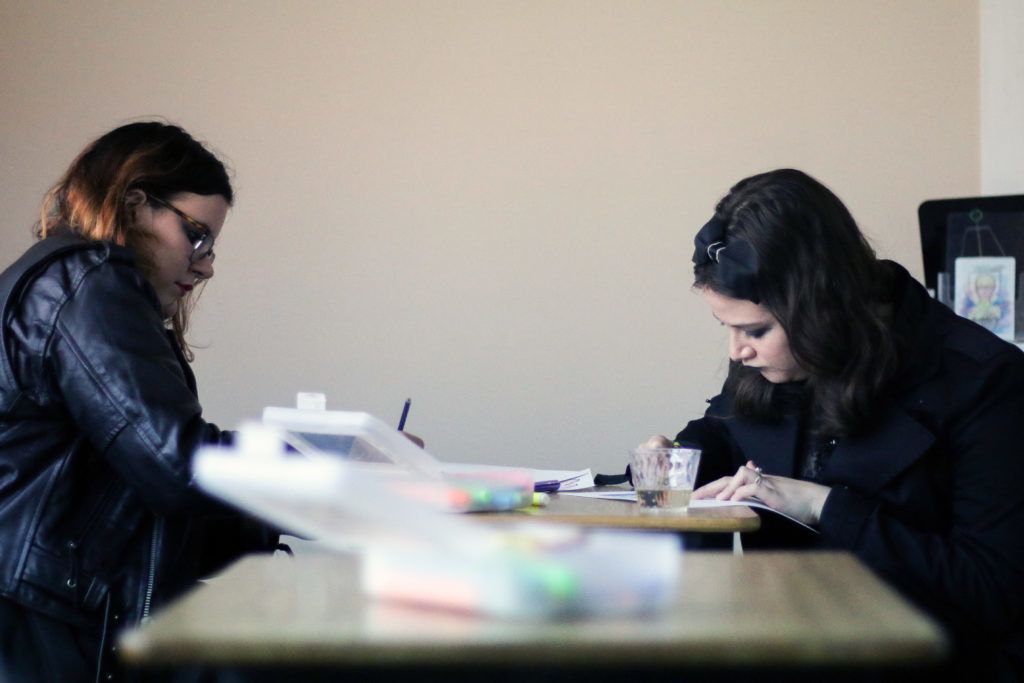Corcoran School of the Arts and Design graduate student Nicole “Ozzy” Osborne didn’t always feel safe at home and would slip out of their house to take solitary walks down their driveway in Tennessee. They said on these nights, they felt free to escape the restraints of society and be fluid in their gender.
Night walks and other childhood memories of gender dysphoria inspired Osborne’s thesis exhibition for their master’s of fine arts degree. The exhibit, stylized “[] Other” and pronounced “Box Other,” includes interactive drawing stations where visitors can experiment with their own coloring projects, and will be on display at Gallery 102 through Friday.
The exhibit features a walkable gravel pathway inspired by Osborne’s driveway, and two rows of desks where viewers can sit and use markers and crayons to color on sheets. Osborne said coloring was how they coped with the rigid social structures in school when they could not openly express their gender identity.
“I didn’t have a choice in my gender when I was back home,” they said. “It was either one way, or I was endangering myself by not doing that.”
For their first piece, Osborne went to the University of Maryland and invited exhibition viewers to color and later donate their drawings to a larger piece that would be projected on the exhibit’s walls. The work, titled “So We Color,” flips through coloring-book style pages that are filled in how visitors wished to represent the blank figure of a student, they said.
“I kept thinking about gender, my own gender, when I felt that my gender was very fluid,” Osborne said. “One of the things that I really remember was that I could still be considered a boy when I was in that prepubescent stage, and that became this ideal figure that kept showing up in a lot of my dreams and a lot of things that were going on, which is the blank figures you see in the animations.”
Osborne later collaborated with high school students for another animation projected onto the walls. The students of Osborne High School, Gatlinburg Pittman High School and Stonewall Jackson High School were told to color in the figure as they think of someone who designates as “other,” the check box offered alongside male and female. A variety of colors, shapes, symbols and words became the combined 360 degree animation of all the coloring sheets.
“It’s completely anonymous, so I don’t even know which one is which student’s work,” Osborne said. “Once they’re all compiled together, you can’t really tell whose is whose, it’s only the student, when they come into the studio space or the gallery space where it’s being shown or online, that will know, ‘oh that’s my piece, that’s my voice.’”
Osborne started going to high schools in the D.C. area and even their alma mater in Tennessee to present to art classes and collect donations for the animation. Osborne said “[] Other” gives a voice to individuals who feel trapped in an academic system and are not able to express their identity.
“When I look at them, I see either individuals who, when presented with a vulnerable form, either they’re showing me their trauma or they’re showing me how they cope with their trauma,” they said.
Osborne said they hope to continue to expand “[] Other” and work with more art teachers and schools, especially in rural areas where they don’t regularly discuss gender.
In an effort to continue the discussion about gender with their family, and people all over, Osborne created a card game titled “Gender Reveal.” They made more than 100 sets of the game that are free to play and take from the gallery. Six months in the making, the game is a mixture of Apples to Apples and Pictionary, and explores how society perceives gender based on articles of clothing.
“When I come home, and I try to talk about gender or sexuality with some of my family members, it devolves into a yelling match,” Osborne said. “I was sitting on the couch with my partner trying to think how could I talk to my family about this in a way that’s not aggressive.”
With interactive games and art exhibits, they hope to further dialogue and recognition of non-normative gender perspectives, which was essential for Osborne to find their place in art and in society, they said.
“When I started going to college, I was looking at gender and I saw male, female and then other as a designation,” they said. “I was like, ‘oh my god, now it all makes so much sense – that’s where I go.'”




